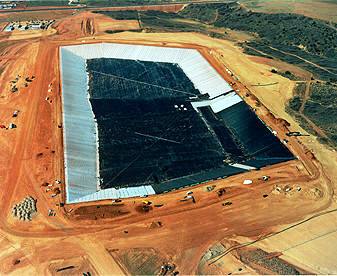
Uranium Mill Tailings Repository Conceptual Design
Southeastern Utah
This project involved a uranium mill tailings repository conceptual design, focusing on hydrogeologic characterization and groundwater flow and projected contaminant transport modeling at the repository site as well as geochemical characterization of leachate from the existing mill tailings piles to be moved to the repository. Site hydrogeologic characterization was completed through compilation and interpretation of site hydrological data, including detailed geologic and hydrologic evaluation of data associated with over 80 soil borings, drill holes, and well completion logs within a one square mile area. The data indicated the presence of a highly transient and discontinuous alluvial groundwater system sensitive to annual recharge as a result of local and region snowmelt. The resulting complex site conceptual model was translated into a saturated/unsaturated two-dimensional profile groundwater flow and transport model. The primary modeling codes used included HYDRUS (finite difference, one-dimensional) and FEMWATER/FEMWASTE (finite element, two-dimensional). The FEMWATER/FEMWASTE model was used to simulate the migration of mill tailings leachate to the native vadose zone and alluvial groundwater system from an unlined (no synthetic liner) repository with a vegetated cover.
Geochemical characterization of leachate was accomplished by designing, installing, and sampling 15 lysimeters constructed within the existing mill tailings piles. Analytical results for samples from the tailings lysimeters were used to geochemically characterize mill tailings leachate at horizons within and below the existing mill tailings piles.
Southeastern Utah
This project involved a uranium mill tailings repository conceptual design, focusing on hydrogeologic characterization and groundwater flow and projected contaminant transport modeling at the repository site as well as geochemical characterization of leachate from the existing mill tailings piles to be moved to the repository. Site hydrogeologic characterization was completed through compilation and interpretation of site hydrological data, including detailed geologic and hydrologic evaluation of data associated with over 80 soil borings, drill holes, and well completion logs within a one square mile area. The data indicated the presence of a highly transient and discontinuous alluvial groundwater system sensitive to annual recharge as a result of local and region snowmelt. The resulting complex site conceptual model was translated into a saturated/unsaturated two-dimensional profile groundwater flow and transport model. The primary modeling codes used included HYDRUS (finite difference, one-dimensional) and FEMWATER/FEMWASTE (finite element, two-dimensional). The FEMWATER/FEMWASTE model was used to simulate the migration of mill tailings leachate to the native vadose zone and alluvial groundwater system from an unlined (no synthetic liner) repository with a vegetated cover.
Geochemical characterization of leachate was accomplished by designing, installing, and sampling 15 lysimeters constructed within the existing mill tailings piles. Analytical results for samples from the tailings lysimeters were used to geochemically characterize mill tailings leachate at horizons within and below the existing mill tailings piles.
